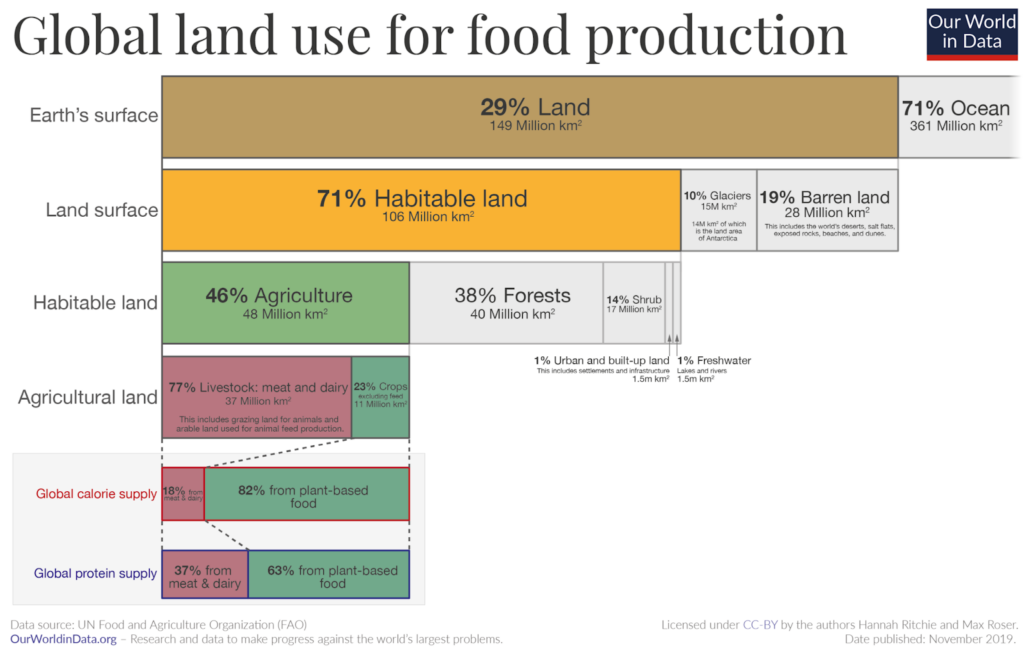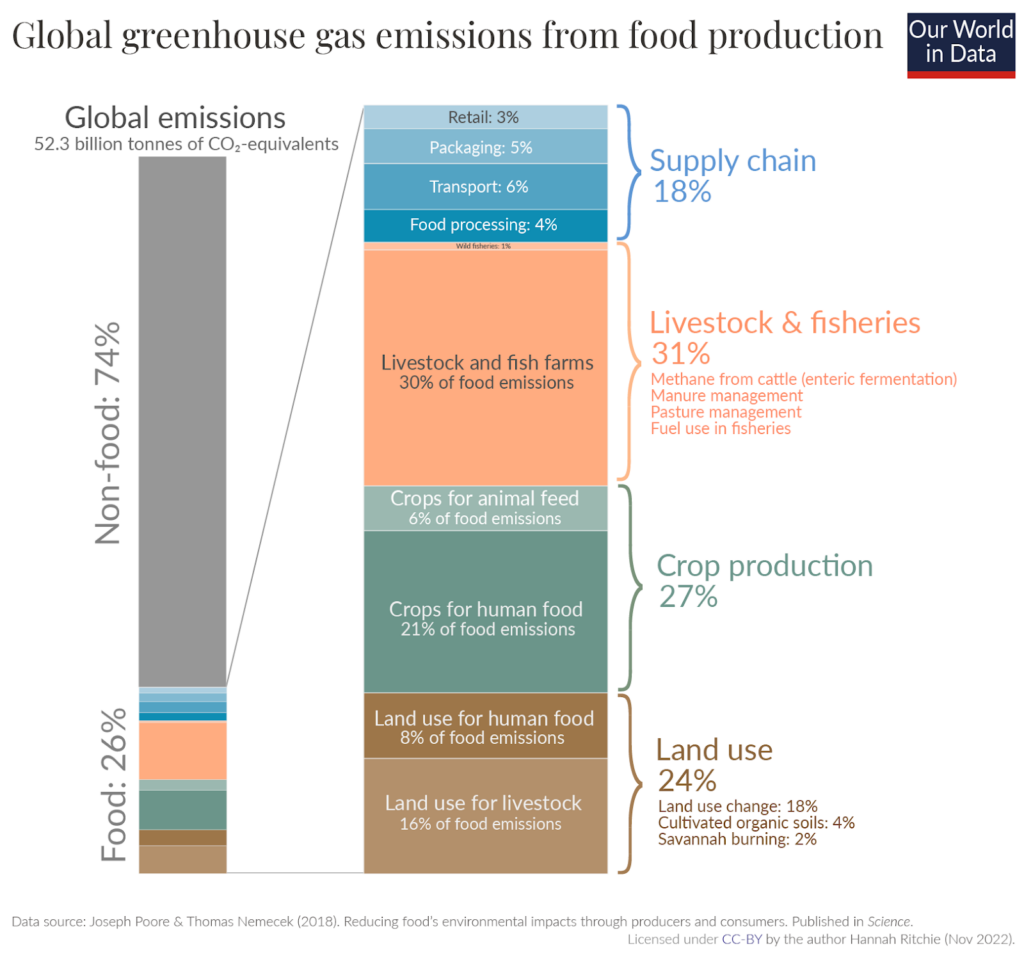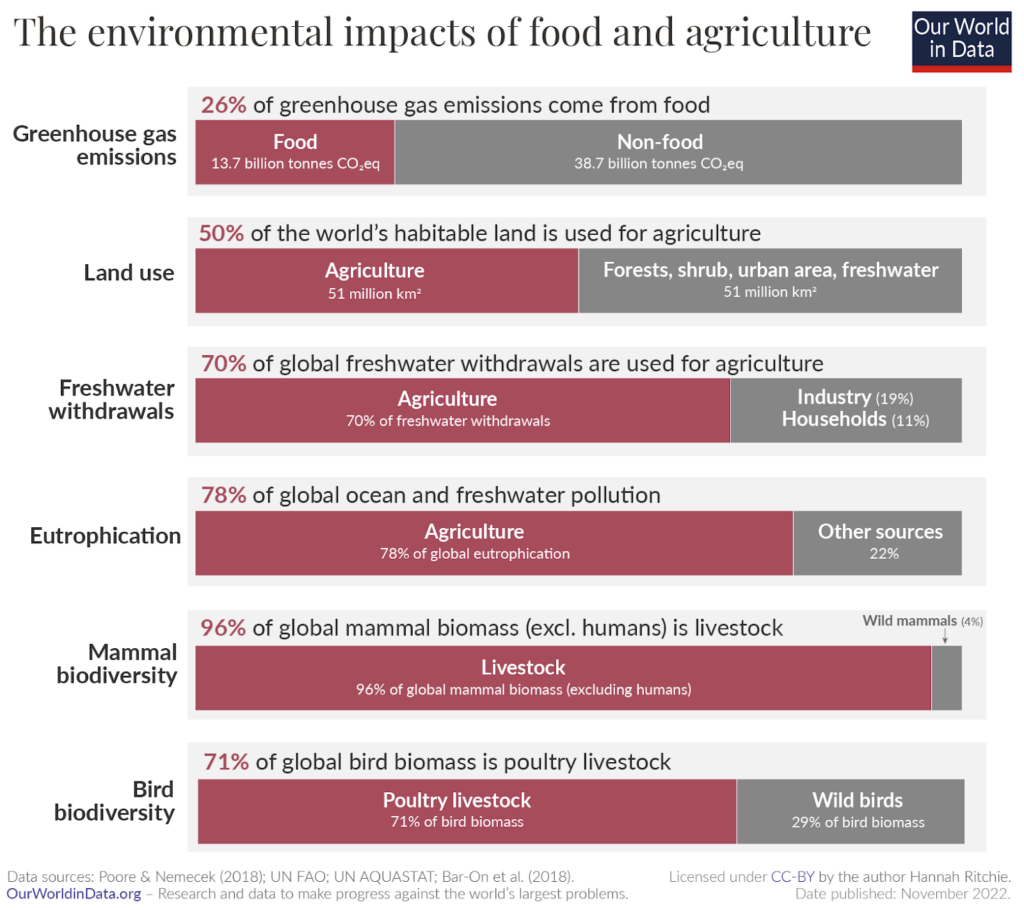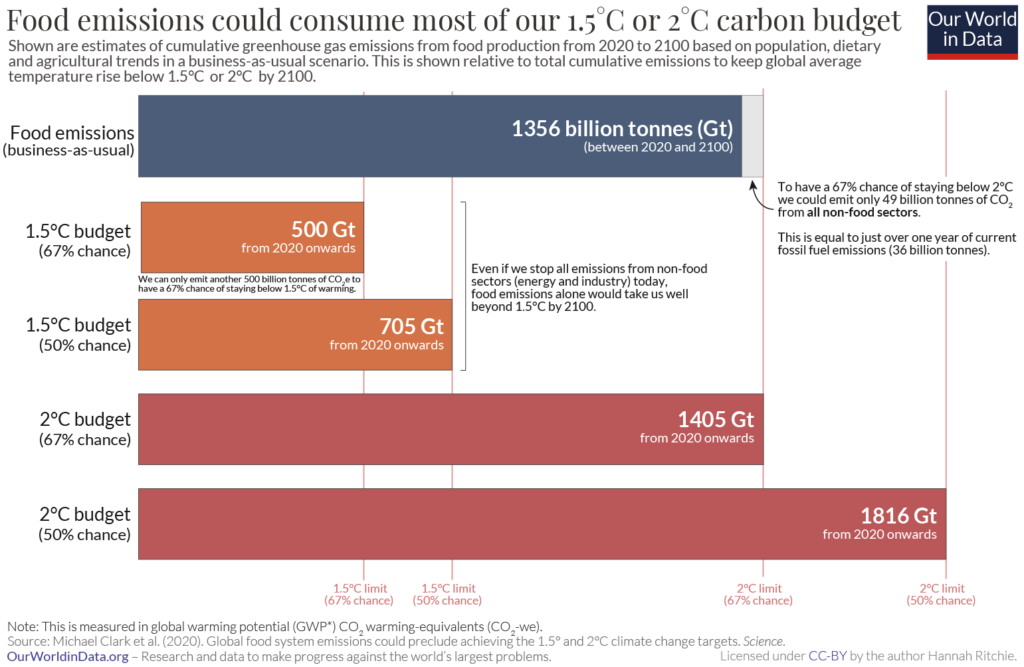The Environmental Impact of Blueberries: From Farm to Table
Impactful Ninja is reader-supported. When you buy through links on our site, we may earn an affiliate commission.
Learn more
Learn more
.
Hey fellow impactful ninja ? You may have noticed that Impactful Ninja is all about providing helpful information to make a positive impact on the world and society. And that we love to link back to where we found all the information for each of our posts. Most of these links are informational-based for you to check out their primary sources with one click. But some of these links are so-called "affiliate links" to products that we recommend. First and foremost, because we believe that they add value to you. For example, when we wrote a post about the environmental impact of long showers, we came across an EPA recommendation to use WaterSense showerheads. So we linked to where you can find them. Or, for many of our posts, we also link to our favorite books on that topic so that you can get a much more holistic overview than one single blog post could provide. And when there is an affiliate program for these products, we sign up for it. For example, as Amazon Associates, we earn from qualifying purchases. First, and most importantly, we still only recommend products that we believe add value for you. When you buy something through one of our affiliate links, we may earn a small commission - but at no additional costs to you. And when you buy something through a link that is not an affiliate link, we won’t receive any commission but we’ll still be happy to have helped you. When we find products that we believe add value to you and the seller has an affiliate program, we sign up for it. When you buy something through one of our affiliate links, we may earn a small commission (at no extra costs to you). And at this point in time, all money is reinvested in sharing the most helpful content with you. This includes all operating costs for running this site and the content creation itself. You may have noticed by the way Impactful Ninja is operated that money is not the driving factor behind it. It is a passion project of mine and I love to share helpful information with you to make a positive impact on the world and society. However, it's a project in that I invest a lot of time and also quite some money. Eventually, my dream is to one day turn this passion project into my full-time job and provide even more helpful information. But that's still a long time to go. Stay impactful,Affiliate Disclosure
Why do we add these product links?
What do these affiliate links mean for you?
What do these affiliate links mean for us?
What does this mean for me personally?
![]()
Blueberries are a popular American fruit, with almost 700 million lbs of them produced every year. They are an amazing addition to baked goods and pack a strong nutritional punch with lots of antioxidants and vitamin K. However, blueberries also use a lot of resources during their production which can do a lot of harm to the environment. So, we had to ask: What is the environmental impact of blueberries?
Blueberries have a very negative impact on the environment. This is mainly because they use plastic packaging, a heavy amount of pesticides, and have a high carbon footprint. However, they also require very little irrigation and sequester carbon very well.
In this article, we will examine the environmental impact of blueberries from several different angles. We will go through the life-cycle of blueberries, detailing their impact on the environment from growth to distribution to your plate to waste management. We will then compare the environmental impact of blueberries to that of other fruits. And, finally, we’ll share some tips with you on how you can reduce your own environmental impact and offset your own carbon emissions—both for your personal life and blueberry-related.
Here’s How We Assessed the Environmental Impact of Blueberries
The Environmental Impact Assessment (EIA) is one of the ways we measure the potential environmental effects of our actions, like the consumption of blueberries. It is a holistic assessment based on the environmental changes associated with our consumption. Those are changes in our environment that can have adverse effects on the air, land, water, fish, and wildlife or the inhabitants of the ecosystem.
“Environmental Impact: the effect that the activities of people and businesses have on the environment”
Cambridge Dictionary
Basically, all goods and services you buy—including blueberries—leave an impact on our environment. When it comes to food in general, and blueberries in specific, the following are key factors:
- Land requirements: Large parts of the world that were once covered by forests and wildlands are now used for agriculture. 10 million hectares of forest are destroyed annually and 50% of the world’s habitable land is now used for agriculture. This loss of natural habitat has been the main driver for reducing the world’s biodiversity.
- Water footprint: 70% of global freshwater is now used for agricultural purposes. By assessing the water footprint of a particular food, we can determine how our limited freshwater resources are being consumed and polluted.
- Pesticide and fertilizer usage: Pesticides and fertilizers provide a range of agricultural benefits. However, numerous studies link pesticides and fertilizers to serious effects on human health, along with disruptions to vital ecosystems and the spread of aquatic dead zones.
- Carbon footprint: The carbon footprint is one of the ways we measure the effects of our human-induced global climate change. Today, food production accounts for over a quarter (26%) of global greenhouse gas emissions.
- Waste generation: Food and its packaging account for almost 45% of the materials landfilled in the US alone. And packaging sent to landfills, especially when made from plastics, does not degrade quickly or, in some cases, at all.
To understand the overall environmental impact of blueberries, we must assess each of their key factors. This Environmental Impact Assessment (EIA) is a tool originally developed to identify the environmental impacts of a project prior to decision-making and also helps us to evaluate the environmental impacts of blueberries, from farm to table.
Here’s the Overall Environmental Impact of Blueberries
The overall environmental impact of blueberries is very negative. The main factors that contribute to this are their low land yield, high pesticide use, plastic packaging, and high carbon footprint.
It must be noted, though, that blueberries have some good qualities when it comes to environmental impact. For one thing, they sequester carbon very well and have very low irrigation requirements. However, these still pale in comparison to the many more damaging qualities they have.
So, let’s have a look at the environmental impact of each key factor of blueberries!
| Key Assessment Factors | Environmental Impact |
| Land requirements for blueberries | Blueberries’ land requirements are fairly high. On top of this, they also use harmful practices like monoculture farming and tend to erode soil. This means their environmental impact is very negative at this stage. |
| Water footprint of blueberries | Blueberries have a moderate water requirement of 50 inches per year. However, because of where they grow, they don’t need to be irrigated, which lowers their water footprint significantly. |
| Agrochemical usage for blueberries | Blueberries’ agrochemical use is fairly high. Their use of ammonium nitrate fertilizer is a particular concern, meaning this stage has a fairly negative environmental impact. |
| Carbon footprint of blueberries | Blueberries have a high carbon footprint of 0.45kg (1lb) of CO2e per pound of blueberries. This is mainly because of their high pesticide use, mechanized farming methods, refrigerated transportation, and use of plastic packaging. Their footprint is significant compared to other fruits. |
| Waste generation of blueberries | Blueberries’ waste generation is moderate. Though they don’t have much organic waste, they use plastic packaging, which usually ends up in landfills. |
These are the overall summaries, but there is a lot more to the story. In the next few sections, we will dive deeper into each stage to illustrate to you all the important aspects of blueberries’ environmental impact.
What Are the Land Requirements for Blueberries
Blueberries’ land requirements are fairly high. On top of this, they also use harmful practices like monoculture farming and tend to erode soil. This means their environmental impact is very negative at this stage.

Growing blueberries has a lot of variables that contribute to their environmental impact. The amount of land they use, the way in which they grow, and the amount of time they take to grow will all contribute to their environmental impact.
How do the land requirements of blueberries impact their environmental footprint?
- What is the land usage of blueberries: Blueberries yield between 10–15 tons per hectare. This is a fairly low land yield compared to other fruits. For example, strawberries yield up to 25 tons per hectare, and bananas up to 100. Therefore, blueberries’ land use contributes moderately negatively to their environmental impact.
- Where and how are blueberries grown: Blueberries are cultivated all over the US, with 26 states producing them commercially. Blueberries grow on bushes that are sometimes farmed, and sometimes wild. These blueberry bushes sequester carbon very well. This means that they are able to capture carbon from the atmosphere and store it in the ground. This lowers their carbon footprint and thus their environmental impact.
- Are blueberries grown in monocultures or polycultures: Blueberries are mainly grown in monocultures. Monocultures are very damaging to the environment and so blueberries’ growing method contributes very negatively to their environmental impact.
- How does the growing of blueberries affect soil fertility and erosion: Blueberry fields are very prone to soil erosion because their roots are poor at holding onto finer soil. Soil erosion can severely damage the lands that they are farmed on, and thus blueberries have a highly negative environmental impact at this stage.
- How does the blueberry industry affect the loss of habitable land: Blueberries use a significant amount of land, mainly because of their low land yield. A 2022 study found that land use was one of the leading negative factors in blueberries’ environmental impact.
- How does the blueberry industry affect wildlife and biodiversity: Monocultures are very damaging to biodiversity. They limit the growth of many important soil microbes and deplete pollinators of the diverse nutrients they need to thrive. This disrupts the whole ecosystem and thus does a lot of environmental harm.
In short, blueberries’ use of monoculture farming, low land yield, and tendency to erode soil all culminate in a very negative growth environmental impact.
What Is the Water Footprint of Blueberries
Blueberries have a moderate water requirement of 50 inches per year. However, because of where they grow, they don’t need to be irrigated, which lowers their water footprint significantly.
Water usage is one of the most important factors in the environmental impact of a fruit. The amount of water used, as well as the way they affect the water sources around them, are all major contributing factors. Here, we will look at these different angles of blueberries’ water impact.
How does the water footprint of blueberries impact their environmental footprint?
- What is the overall water usage of blueberries: Blueberries need about 50 inches of water per year. This is a very average water requirement for fruits and so their water footprint is moderate.
- What is the green water footprint of blueberries: The green water footprint is the amount of water from precipitation stored in the soil and used by plants for growth. Most blueberries consumed by Americans are grown in Washington state, which can get up to 100 inches of rain per year. This means that only about half the annual rainfall needs to go towards blueberry irrigation. Therefore, blueberries have an extremely low green water footprint.
- What is the blue water footprint of blueberries: The blue water footprint is the amount of water sourced from surface (such as rivers or lakes) or groundwater resources. Since Washington’s annual rainfall is more than enough to satisfy blueberries’ water requirements, they don’t need irrigation. As a result, their blue water footprint is small to zero.
- What is the gray water footprint of blueberries: The gray water footprint is the amount of freshwater required to clean up water pollution to meet certain quality standards. Essentially, it’s the amount of water needed to make polluted water clean enough to be safe and healthy for humans and the environment. Blueberries have very high pesticide usage. This means that a high amount of water is needed to clean up their pesticide residue, raising their gray water footprint significantly.
- How does the blueberry industry affect freshwater and ocean pollution: Pesticides are a major water polluter, especially in rainier climates, like Washington, where runoff is more common. Because they use a significant amount of pesticides, blueberries contribute significantly to freshwater and ocean pollution.
In short, blueberries’ lack of irrigation requirements means that their water footprint is very low, despite their use of water-polluting pesticides.
What Is the Agrochemical Usage for Blueberries
Blueberries’ agrochemical use is fairly high. Their use of ammonium nitrate fertilizer is a particular concern, meaning this stage has a fairly negative environmental impact.
Pesticides and fertilizers are agrochemicals that can have a significant negative impact on the environment. They both require resources to create as well as have effects on the life around them. Here, we will look at how blueberries’ pesticide and fertilizer rates affect their environmental impact.
How does the agrochemical usage of blueberries impact their environmental footprint?
- What is the pesticide usage of blueberries: Blueberries use a high amount of pesticides. Pesticides can cause many kinds of environmental damage, including poisoning surrounding wildlife, and leakages getting into soil and groundwater. In this way, blueberries have a very negative environmental impact.
- What is the fertilizer usage of blueberries: Blueberries typically use fertilizers ammonium sulfate and ammonium nitrate. Ammonium sulfate generally has a minor environmental impact. Ammonium nitrate, however, is more harmful to the environment. As a result, fertilizer contributes moderately to blueberries’ environmental impact.
- Are there any known issues connected to the agrochemical usage for blueberries: Ammonium nitrate carries a number of risks, such as the risk of explosion due to poor storage. These pose more immediate environmental risks, which are still a concern.
In short, blueberries’ use of agrochemicals like pesticides and ammonium nitrate contribute fairly negatively to their environmental impact.
What Is the Carbon Footprint of Blueberries
Blueberries have a high carbon footprint of 0.45kg (1lb) of CO2e per pound of blueberries. This is mainly because of their high pesticide use, mechanized farming methods, refrigerated transportation, and use of plastic packaging. Their footprint is significant compared to many other fruits.

Carbon footprint is one aspect of the overall environmental impact of a fruit. It essentially measures how much carbon or other greenhouse gasses the production of strawberries emits into the atmosphere. Emissions from product manufacturing, irrigation, transportation fuel, and landfills all add up to create the overall carbon footprint of a fruit. Let’s see how the carbon footprint of blueberries breaks down and contributes to their environmental impact.
How does the carbon footprint of blueberries impact their environmental footprint?
- What is the overall carbon footprint of blueberries: The overall carbon footprint of blueberries is 0.45kg (1lb) of CO2e per pound of blueberries. This means that for every pound of blueberries, 0.45kg of carbon is released into the atmosphere. This is a very high carbon footprint for a fruit, especially for a berry. For example, raspberries have a carbon footprint of 0.15kg (0.33lb) of CO2e per pound of raspberries.
- What are the main contributors to the carbon footprint of blueberries: The main factors that contribute to blueberries’ environmental impact are mechanized farming, high pesticide use, and the use of plastic packaging.
- Which life-cycle stage of blueberries has the highest carbon footprint: Harvesting and packaging is the stage that contributes the most to blueberries’ carbon footprint. This is because they are harvested and processed mechanically, and use plastic packaging, which requires carbon emissions to produce.
In short, blueberries have a lot of high-emitting steps in their manufacturing process, leading them to have an above-average carbon footprint for a fruit.
What Is the Waste Generation of Blueberries
Blueberries’ waste generation is moderate. Though they don’t have much organic waste, they use plastic packaging, which usually ends up in landfills.
When fruit waste—either packaging or organic materials—is disposed of, it can have a major impact on the environment. Whether it’s damaging wildlife, getting into oceans, emitting methane, or dissolving into microplastics that contaminate groundwater, all these materials have their part to play. In this section, we will look at how blueberries’ waste affects the environment.
How does the waste generation of blueberries impact their environmental footprint?
- What is the packaging of blueberries: Blueberries are typically packaged in either cardboard trays or plastic clamshells. Both cardboard and plastic have negative environmental impacts during their production alone—cardboard because of deforestation and plastic because of greenhouse gas emissions and chemical runoff. Because they use these types of packaging, blueberries have a very high packaging impact.
- How is the packaging of blueberries disposed of: Plastic and cardboard can both generally be recycled, but they aren’t recycled at the same rates in practice. Cardboard has a very high recycling rate at 89%, whereas plastic has a very low recycling rate at 9%. Therefore, the plastic portion of blueberry packaging is very likely to end up in landfills. Landfills cause significant environmental damage, including land clearance and chemical pollution. Furthermore, plastic can take up to 500 years to decompose. Blueberries’ use of plastic packaging thus has a very negative environmental impact.
- How are blueberries disposed of: Blueberries are generally consumed whole, so they don’t have significant consistent food waste. They also have a significantly longer shelf life than other fruits, which means that spoilage is not too much of a risk. Overall, food waste does not contribute very meaningfully to blueberries’ environmental impact.
In short, blueberries’ use of plastic packaging is the main culprit in their waste footprint, with much of it ending up in landfills.
What Have Been Historical Environmental Issues Connected to the Blueberry Industry
The blueberry industry has historically been very damaging to the environment. They have caused significant land loss, species loss, and water pollution.
All fruits have had a complex journey toward global distribution. They originate in one part of the world and often travel far to end up in your local supermarket. From farm to table, some of our favorite fruits have racked up some serious environmental damage along the way. Whether it’s deforestation to meet demand, water pollution, or disruption of wildlife, most fruits have left a path of destruction. Let’s see how blueberries have fared throughout history.
What have been the key environmental issues of the blueberry industry?
- How much land has been lost because of blueberry production: Blueberry farming has been identified as a driving force of deforestation in Georgia. Since blueberry farms are more profitable than Georgia’s forests, farmers have been looking towards deforestation. Between 2010 and 2017, over 15,000 hectares of land were deforested in Georgia to make way for blueberry farms. This is a devastating loss of land and represents the damage to natural land that agriculture can create.
- Which wildlife species have been negatively impacted or displaced because of blueberry production: Georgia has the highest deforestation rate in the US. All of these forests are habitats for many kinds of wildlife. Since habitat loss is the leading cause of endangered species, blueberry farming has contributed significantly to the loss of Georgia’s wildlife. Some of the endangered species of Georgia include the Appalachian cottontail and the gray bat.
- Have water sources and soil been contaminated because of blueberries production: Agricultural pollution, including pesticides, is the leading cause of water pollution. Because blueberries have used so many pesticides throughout their years of cultivation, they have caused harm to a significant number of water sources.
In short, the history of the blueberry industry is rife with environmental damage. From habitat loss to water pollution, blueberries have had a hand in many different kinds of environmental destruction.
What Is the Overall Environmental Impact of Food and Agriculture
Food production in general has a high environmental impact. Everything from the amount of land used to the energy involved in irrigation to its effect on plant and animal biodiversity can be a factor in this. In the chart below, you can see how food production is one of the biggest influences on these areas of the environment.

Agriculture alone accounts for over a quarter of global greenhouse gas emissions, while using half of the world’s habitable land and 70% of the global freshwater withdrawals. Agriculture also causes 78% of the global ocean and freshwater pollution.
Livestock accounts for the vast majority of non-human mammal and bird biomass. Mammal livestock outweighs wild mammals by a factor of 15-to-1, and poultry livestock outweighs wild birds by a factor of more than 3-to-1.
These statistics highlight the need for sustainable and responsible practices in food production to reduce its impact on the environment. And the need for us to shift toward more environmentally-friendly foods.
How Can You Reduce Your Environmental Impact and Offset Your Personal Carbon Footprint
There are a few things you can do to mitigate some of the negative environmental effects of consuming blueberries, while still enjoying them. You can also consider offsetting your personal and blueberry-related carbon emissions, which will work to remove carbon emissions elsewhere that are then attributed to you. Here, we will walk you through how to accomplish both of these things.
How Can You Reduce Your Environmental Impact When Shopping for Blueberries
In this section, we give you a short list of ways you can reduce the negative environmental effects of blueberries, based on those parts of the life-cycle of blueberries that would otherwise most negatively impact the environment:
- Buy organic blueberries: Pesticides are a major contributor to blueberries’ environmental impact. Organic farms generally avoid high amounts of chemical pesticides and so they will have a much smaller environmental impact in this area.
- Choose cardboard packaging: If you are able to make the choice, cardboard packaging has a smaller environmental impact than plastic packaging because it is easier to recycle. Therefore, if you have the option, it is much better to choose the blueberries that come in cardboard rather than plastic containers.
- Recycle or compost cardboard: Even if you choose cardboard packaging, there is still a risk that it may end up in a landfill. As a result, you should make sure to recycle all blueberry packaging. Alternatively, you could even use it in compost, since cardboard is biodegradable.
Following some of these methods can really help you cut down on your environmental impact of eating blueberries. None of these will completely eradicate these negative impacts, since there are always effects that may be outside of your control. But some reduction is always better than nothing!
Which Organizations Can You Support to Help Alleviate Your Environmental Impact
While blueberries can cause a wide range of environmental damage, there are also some organizations that help you reduce parts of your impact that would otherwise be outside of your control. These organizations are working hard to prevent and reverse damage to the environment caused by industries like blueberry agriculture.
In the table below are some of the best environmental charities that work in the areas where blueberries production has affected the environment—and beyond:
Though it is helpful to reduce the environmental impact of your personal blueberry consumption, supporting these organizations takes your positive impact a step further. You will be reaching far beyond your own consumption impacts and helping to build a better world for everyone!
How Can You Offset Your Personal Carbon Footprint
The carbon footprint is a key part of your environmental impact. And it is one of the ways we measure the effects of our human-induced global climate change. Yes, even from eating blueberries!
“Carbon footprint: the amount of greenhouse gasses and specifically carbon dioxide emitted by something (such as a person’s activities or a product’s manufacture and transport) during a given period”
Merriam Webster
Basically, it is the amount of carbon emitted by you as an individual or an organization providing you with goods and services—including blueberries:
- This includes GHG emissions from producing the products that we use and foods that we eat (e.g., power plants, factories or farms, and landfills)
- GHG emissions from fuel that we burn directly or indirectly (e.g., logistics and transportation, cooling or heating facilities),
- as well as the GHG emissions attributed to how we consume these products and foods.

Carbon offsets are reductions in carbon emissions that are used to compensate for carbon emissions occurring elsewhere—for example for the carbon emissions that are associated with blueberries. They are measured in tons of CO2 equivalents and are bought and sold through international brokers, online retailers, and trading platforms on what is known as the global carbon offset market.
“Carbon Offset: a way for a company or person to reduce the level of carbon dioxide for which they are responsible by paying money to a company that works to reduce the total amount produced in the world, for example by planting trees”
Oxford Dictionary
In terms of blueberries – and indeed all food types – there will always be a carbon footprint, because of the resources it takes to get your food from farms to the place where you’ll eventually eat them. And while there are ways to reduce your carbon footprint when shopping for blueberries, carbon offsets would be a way to reduce your CO2e emissions all the way down to net zero (or even to become climate positive).
However, when you purchase carbon offsets, it’s important that they actually make a difference in offsetting (aka reducing) total carbon emissions. To achieve that, the following are key criteria:
- Carbon offset projects have to be effective (different projects have different effectiveness rates)
- Carbon offset projects have to be additional
- Carbon offset projects have to be permanent
- The claims from carbon offset projects have to be verifiable
To find the best carbon offsets for you personally, check out our full guide on the best carbon offsets for individuals, where you’ll also learn more about how these carbon offset projects work, what their respective offsetting costs are, and what your best way would be to offset your own carbon emissions.
Final Thoughts
Blueberries are certainly not the most environmentally-friendly fruits. They use some very harmful agrochemicals like pesticides and ammonium nitrate, are packaged in plastic, and emit a lot of carbon. However, there are still steps you can take to change this. Consuming organic blueberries and disposing of packaging responsibly can help reduce their impact. You can also consider supporting some organizations that are working to reduce overall agricultural environmental damage. These steps will help you become a more environmentally-friendly blueberry consumer!
Stay impactful,

Sources
- AGMRC: Blueberries
- WebMD: Health Benefits Blueberries
- UNEP: Environmental Impact Assessment
- UN: Forests, Desertification, and Biodiversity
- Our World in Data: Food Production is Responsible for One Quarter of the World’s Emissions
- WHO: Preventing Disease Through Healthy Environments
- Science Direct: Worldwide Decline of the Entomofauna
- EPA: Agriculture Sources and Solutions
- EPA: Reducing Food Waste Packaging
- Foodprint: The Environmental Impact of Food Packaging
- Plantophiles: Blueberry Watering
- Impactful Ninja: What is the Carbon Footprint of Blueberries
- Our World in Data: Environmental Impacts of Food production
- Harvesso: Blueberry
- Impactful Ninja: What is the Carbon Footprint of Strawberries
- Impactful Ninja: What is the Carbon Footprint of Bananas
- Blueberry.org: Where Do Blueberries Grow
- California Grown: How Are Blueberries Grown
- CDN Science: Seasonal Growth Dynamics and Carbon Allocation of the Wild Blueberry
- National Grid: What is Carbon Sequestration
- Impactful Ninja: Why is a Carbon Footprint Bad for the Environment?
- NBI Health: Toxic Blueberries and 2.2 Billion Other Reasons to Eat Organic
- The Independent: Avocado, Coffee, and Citrus Fruit Threaten Global Food Security
- CDN: Protection of Lowbush Blueberry Soils From Erosion
- WWF: Effects of Soil Erosion and Land Degradation
- Science Direct: Environmental Behavior of Blueberry Production
- Gallant Intl: Environmental Impacts of Monocultures
- Water Footprint: What is a Water Footprint?
- Hort Daily: World’s Top Ten Blueberry Producing Countries
- WRCC: Annual Precipitation Washington
- Daily Mail: Superfoods Like Blueberries, Spinach, and Kale Laced with Dangerous Chemicals
- Permaculture News: Pesticides and Water Pollution
- Pesticide Stewardship: The Problem of Runoff
- Friends of the Earth: Effects of Pesticides on Our Wildlife
- USGS: Pesticides in Groundwater
- Extension: Suggested Blueberry Fertilization
- Arkema: GPS Safety Summary
- Research Gate: Environmental Impact of Ammonium Nitrate Fertilizer
- GICHD: Reducing Risks Associated with Ammonium Nitrate
- Our World in Data: Environmental Impacts of Food Production
- Impactful Ninja: What is the Carbon Footprint of Raspberries
- WSU: Harvesting Blueberries
- TIS: Blueberries Transportation
- City to Sea: How Does Plastic Contribute to Climate Breakdown
- TRVST: Environmental Impact of Cardboard
- ITP Packaging: Is Plastic Packaging Bad for the Environment?
- Also Known As: 12 Interesting Facts About Packaging
- Colorado: Hidden Damage of Landfills
- Forge Recycling: How Long It Takes For Everyday Items to Decompose
- NCBI: Proper Storage for Blueberries
- Science Direct: The Role and Potential of Blueberry in Increasing Deforestation
- Trees Atlanta: Georgia Leads the Way in Urban Tree Loss
- National Geographic: Endangered Species
- Earth’s Endangered: Endangered Species List Georgia
- NRDC: Water Pollution
- Our World in Data: Environmental Impacts of Food
- UVM: Sources of Nitrogen for Organic Farmers
- Gardening Knowhow: Composting Cardboard
- Impactful Ninja: Best charities that fight to protect our environment
- Impactful Ninja: Best charities for reforestation
- Impactful Ninja: Best wildlife conservation charities
- Impactful Ninja: Best charities for protecting the Amazon rainforest
- Impactful Ninja: Best charities that protect our national parks
- Impactful Ninja: Best charities that fight for clean water
- Impactful Ninja: Best charities that help conserve our rivers
- Impactful Ninja: Best charities to save our oceans
- Impactful Ninja: Best charities that help farmers
- Impactful Ninja: Best charities for helping farm animals
- Impactful Ninja: Best charities for climate change
- Impactful Ninja: Best carbon offsets for individuals
- Impactful Ninja: Best charities that fight to reduce food waste
- Impactful Ninja: Best charities that fight to end plastic pollution
- Our World in Data: Emissions from food alone would take us past 1.5°C or 2°C this century
- Impactful Ninja: Best Carbon Offsets for Individuals




